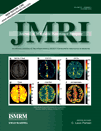Longitudinal and multi-echo transverse relaxation times of normal breast tissue at 3 Tesla
Abstract
Purpose
To measure longitudinal (T1) and multi-echo transverse (T2) relaxation times of healthy breast tissue at 3 Tesla (T).
Materials and Methods
High-resolution relaxation time measurements were made in six healthy female subjects. Inversion recovery images were acquired at 10 inversion times between 100 ms and 4000 ms, and multiple spin echo images were acquired at 16 echo times between 10 ms and 160 ms.
Results
Longitudinal relaxation times T1 were measured as 423 ± 12 ms for adipose tissue and 1680 ± 180 ms for fibroglandular tissue. Multi-echo transverse relaxation times T2 were measured as 154 ± 9 ms for adipose tissue and 71 ± 6 ms for fibroglandular tissue. Histograms of the voxel-wise relaxation times and quantitative relaxation time maps are also presented.
Conclusion
T1 and multi-echo T2 relaxation times in normal human breast tissue are reported. These values are useful for pulse sequence design and optimization for 3T breast MRI. Compared with the literature, T1 values are significantly longer at 3T, suggesting that longer repetition time and inversion time values should be used for similar image contrast. J. Magn. Reson. Imaging 2010;32:982–987. © 2010 Wiley-Liss, Inc.




